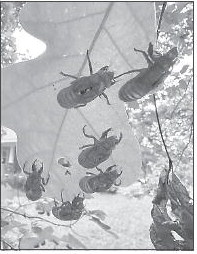They’re Here


Our mail delivery person drove up to our house last Friday and jumped out onto the driveway with a small package. I met her at her vehicle, and we exchanged pleasantries.
“Are they cutting timber around here?” she asked as she turned back toward the mail truck.
I smiled and asked, “Are you referring to that loud buzzing sound?”
“Yeah. Where are they cutting?” I smiled again. “No one’s cutting timber around here. It’s the cicadas. They’re here. That loud buzzing sound you hear is them — high in the treetops, all around us.”
“No way!” she said, raising her voice, her mouth falling open. “They’re that loud?”
I nodded. My husband and I started hearing the rhythmic humming last Monday afternoon. At first, I thought a distant neighbor’s home security alarm was going off. But the following day, I heard it again, and it was louder. And as I walked around our yard and garden, I noticed tiny holes in the ground, along with the flying cicadas and their exoskeletons scattered everywhere. That ’s when I put two and two together and rea lized that the cicadas had arrived in Nor thw est Georgia.
If you’ve seen a newscast or read a newspaper in the last two weeks, you probably know that trillions — trillions — of cicadas belonging to Brood XIX (19) are crawling out into the light from their underground burrows all across the South this month, when the soil temperatures reach about 64 degrees Fahrenheit.
These particular periodical cicadas, the ultimate underground dwellers, live in the soil for over 99% of their existence as kiddo bugs (nymphs). But then they decide to hit the surface, and it’s party time! Every 13 years, masses of them emerge for a few wild weeks of adulting — molting, mating, disturbing the peace, laying eggs — and then, poof, the adults die, eggs hatch, and the nymphs head underground. And the cycle repeats.
And we humans witness this grand insect spectacle — and moreover, we hear it! The buzzing at our house is so loud that I can’t even sit on the front porch and talk on my phone during the daytime. I’ve also wondered if my husband and I should be wearing hearing protection while outdoors. Today, as I sit at my desk indoors, I can hear them out there — through the walls and windows of our home.
As for nature’s purpose, periodical cicadas are like the all-you-can-eat buffet for predators, keeping the local wildlife well-fed and happy for a while. And when they finally kick the bucket, they transform into soil snacks as they decompose and serve up nutrients to the dirt.
That’s the upside of cicadas, but there is a downside, too, other than the incessant buzzing they create. They also pose a threat to saplings. The females make slits and lay eggs in branches less than ¼ inch in diameter (about the size of a pencil). This egg-laying doesn’t do serious harm to mature trees, but it can damage very young trees.
As for their exoskeletons — they are everywhere right now. They are hooked to tree trunks, limbs, and leaves throughout our property, and they are scattered across the ground, crunching as we walk as if we’re stepping on a layer of Lay’s potato chips.
In the past, I’ve shared the story continued from page
of how my father hooked a hollow, crispy shell to my nose when I was a very young girl. I stood as still as a statue and crossed my eyes trying to see it. After that day, I collected them. Today, they connect me to my childhood.
“I also collected them when I was young,” my husband’s biological mother shared with us a few days ago. “I’d take their delicate shells and put them in matchboxes and stack them in my room, so they wouldn’t get crushed.”
And so, yesterday, we plucked some exoskeletons from some oak leaves to place in a small box for her. We plan to ship them over to Texas this week, sending her a small reminder of her childhood, and just in time for Mother’s Day. As the symphony of cicadas crescendos, enveloping us in their buzzing chorus, it’s impossible not to be swept away by the magic of it all. These winged creatures, with their quirky life cycles and boisterous gatherings, remind us to stop and notice the extraordinary wonders of the world, and most of all, find the joy and uniqueness of each and every day.







out of
Posted on